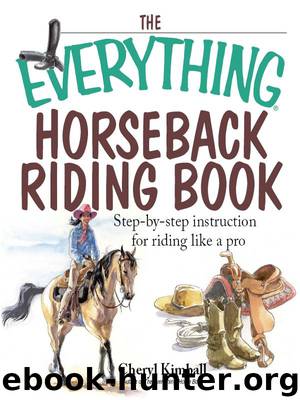The Everything Horseback Riding Book by Cheryl Kimball

Author:Cheryl Kimball
Language: eng
Format: epub
Tags: subject
ISBN: 9781440523496
Publisher: Adams Media
Published: 2011-06-24T00:00:00+00:00
The canter is the fastest of a horse's three basic gaits.
A “stride” refers to the full cycle of all the footfalls of a particular gait, starting with a hind foot. So one canter stride consists of the three distinct phases of the four legs (two legs move together) and the moment of suspension.
Leads
The canter is a gait about which you will hear the term “leads.” A horse is cantering on either a left lead or a right lead. The easiest way to tell which lead the horse is on when watching him move at the canter is to look for the front leg that moves out in front the farthest. The hind leg on the opposite side would have been the original thrust of the canter. So if the horse is on a “right lead,” the left hind leg would have pushed off as the first beat in the stride. Then the right hind leg and the left front leg move together, followed by the right front, or leading leg, which stretches out in front farther than the other front leg did. Of course, the opposite occurs on the left lead.
The Natural Lead
Horses naturally balance themselves—they are exceptionally good at putting their feet where they need to be to keep that big body above ground. So when a horse is cantering in a clockwise direction, it's natural for him to be on his right lead, allowing for a better balance in the direction of the clockwise curve.
Cross Cantering
When a horse takes off on a hind leg but does not follow the canter sequence of footfalls, it's referred to as cross cantering. This could be dangerous for both you and the horse. He could easily strike a front foot with a hind or simply get off balance and fall. You can almost immediately feel this awkward and jerky movement.
Counter Cantering
Counter cantering is when the horse takes up the lead opposite from the natural lead he should take considering the direction he is going. So a left lead while cantering clockwise is considered a “counter canter.” This is sometimes used intentionally to build up muscles and balance in a young or developing horse. Later in this chapter, you will learn how to request the canter from your horse, and therefore how you would request the counter canter.
Observing the Canter
As with the walk and the trot, it helps you to watch horses move on their own to understand the canter and how to ride it.
Loose Horses
Loose horses travel so smoothly and naturally that it's important to watch them whenever you get the opportunity. You will see the purest movement the horse has to offer without the impediment of trying to balance a 130-pound vertically oriented human on his back. Try to watch horses in a place with great footing, like an indoor or outdoor arena. Then you can watch the horses moving freely without concern for rocks and other obstacles.
Watch which legs move when. Concentrate on one leg at a time so you can focus on the movement—you'll find that it's pretty hard to watch two or more legs at once.
Download
This site does not store any files on its server. We only index and link to content provided by other sites. Please contact the content providers to delete copyright contents if any and email us, we'll remove relevant links or contents immediately.
| Equestrian | Polo |
| Racing |
Shoe Dog by Phil Knight(5222)
The Rules Do Not Apply by Ariel Levy(4912)
Walking by Henry David Thoreau(3926)
How to Read Water: Clues and Patterns from Puddles to the Sea (Natural Navigation) by Tristan Gooley(3434)
Running Barefoot by Amy Harmon(3420)
I'll Give You the Sun by Jandy Nelson(3399)
Crazy Is My Superpower by A.J. Mendez Brooks(3360)
How to Read Nature by Tristan Gooley(3295)
How Music Works by David Byrne(3237)
The Boy, the Mole, the Fox and the Horse by Charlie Mackesy(3069)
The Fight by Norman Mailer(2893)
Seducing Cinderella by Gina L. Maxwell(2619)
Cuba by Lonely Planet(2605)
Accepted by Pat Patterson(2337)
Going Long by Editors of Runner's World(2328)
The Unfettered Mind: Writings from a Zen Master to a Master Swordsman by Takuan Soho(2275)
Backpacker the Complete Guide to Backpacking by Backpacker Magazine(2215)
The Happy Runner by David Roche(2214)
Trail Magic by Trevelyan Quest Edwards & Hazel Edwards(2147)
